When life throws unexpected challenges your way, being ready can make all the difference. A well-organized collection of essential items ensures you’re equipped to handle sudden disruptions, from power outages to natural disasters. Think of it as your personal safety net—something every household should prioritize.
So, what goes into a reliable preparedness kit? Start with basics like water (one gallon per person daily) and non-perishable snacks. Add a first-aid pack with bandages, pain relievers, and prescription meds. Don’t forget tools like flashlights, batteries, and a multi-purpose knife. Experts at Redfora suggest keeping these easy-to-grab in a durable backpack or sealed plastic bin.
Why does this matter? Crises rarely give warning. Having your gear sorted means less stress when minutes count. It’s about staying self-reliant until help arrives or normalcy returns. Plus, updating your stash seasonally—like adding blankets in winter—keeps it practical year-round.
Ready to take action? Begin today by listing must-haves and checking expiration dates. Store everything in a spot everyone knows. Small steps now create big peace of mind later.
Understanding the Importance of Emergency Supplies
Being prepared isn’t just caution—it’s a lifeline during chaos. Imagine a storm knocks out power for days or a wildfire forces sudden evacuation. Without essentials like water and food, even minor disruptions become dangerous. Proper preparedness turns panic into calm action when every second counts.
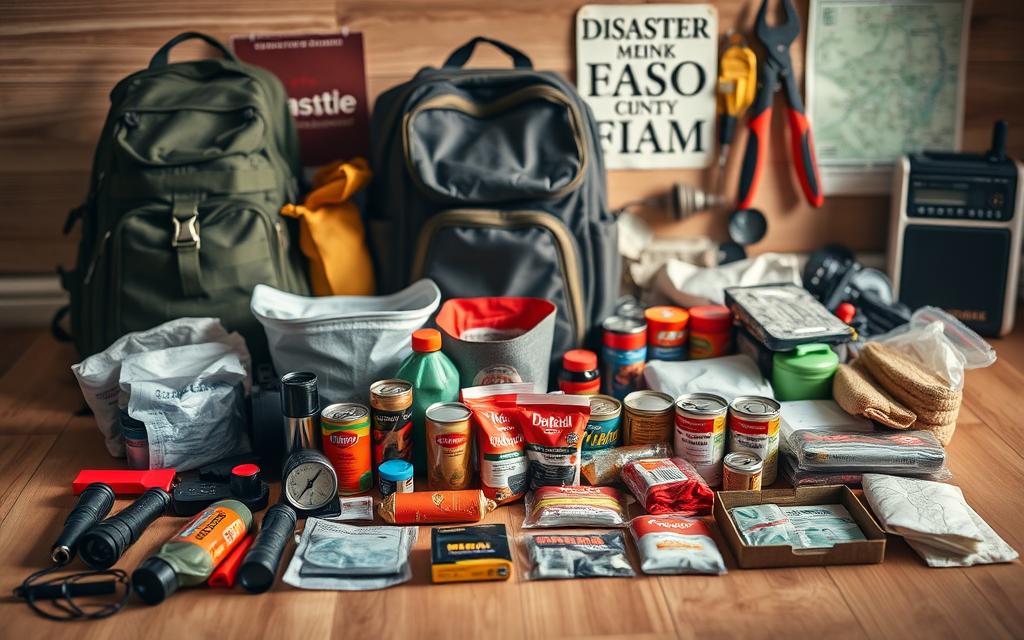
Water is your top priority. Experts recommend storing one gallon per person daily—enough for drinking and basic hygiene. A family of four needs 12 gallons for just three days. Non-perishable snacks like energy bars or dried fruit provide quick calories without refrigeration. These basics create a safety buffer while waiting for assistance.
Why individual kits? Shared resources drain fast during crises. Personal packs ensure everyone has what they need. Include items like flashlights, local maps, and portable phone chargers. These tools help navigate darkened streets or find evacuation routes when networks fail.
A well-stocked home reduces risks dramatically. Studies show households with kits recover 50% faster after disasters. Rotate items every six months and customize based on local risks—like extra blankets for cold climates. Small efforts today build resilience for tomorrow’s unknowns.
Essential Components of a Robust Emergency Kit
A reliable preparedness kit acts like a safety toolbox—every item serves a purpose when life takes an unexpected turn. Let’s break down the non-negotiable elements that keep families safe and comfortable during disruptions.
Water, Food, and Sanitation Essentials
Start with water: store one gallon daily per person for at least three days. Use sturdy containers and replace them every six months. For food, focus on non-perishables like granola bars, canned beans, and dried fruits. These options require no cooking and stay fresh for months.
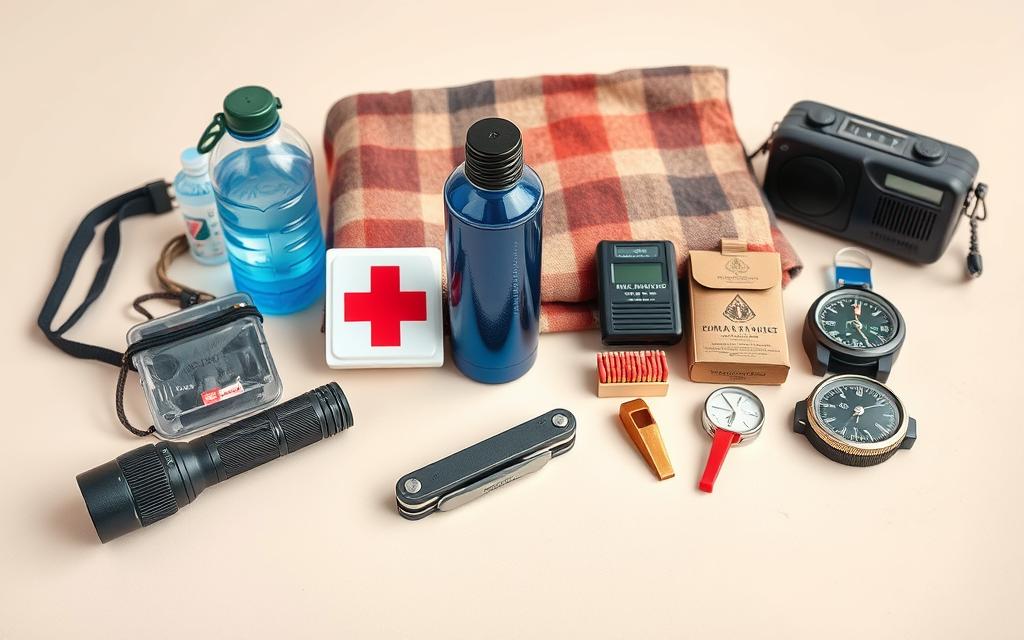
Sanitation matters just as much. Pack moist towelettes, hand sanitizer, and garbage bags in airtight plastic pouches. These items prevent contamination and maintain cleanliness if plumbing fails.
First Aid and Personal Hygiene Items
A basic first aid kit needs bandages, antiseptic wipes, pain relievers, and prescription medications. Add tweezers and gloves for minor injuries. Don’t overlook personal hygiene—include travel-sized soap, toothpaste, and menstrual products to stay healthy.
Combine these essentials into a compact, labeled kit. Store it where everyone can grab it quickly. Simple planning today ensures you’re ready for tomorrow’s surprises.
Building a Customized Emergency Kit for Your Family
Every family’s needs are as unique as their fingerprints—customizing your preparedness plan ensures no one gets left behind. While standard kits cover basics, tailoring yours addresses who matters most: energetic toddlers, aging parents, or furry companions.
Special Considerations for Pets, Seniors, and Children
Start by adding items that match your household’s daily rhythms. Pets need extra food, collapsible bowls, and vaccination records. Seniors often require prescription medications, hearing aid batteries, or mobility aids. For kids, include comfort items like small toys or coloring books to ease stress during chaotic moments.
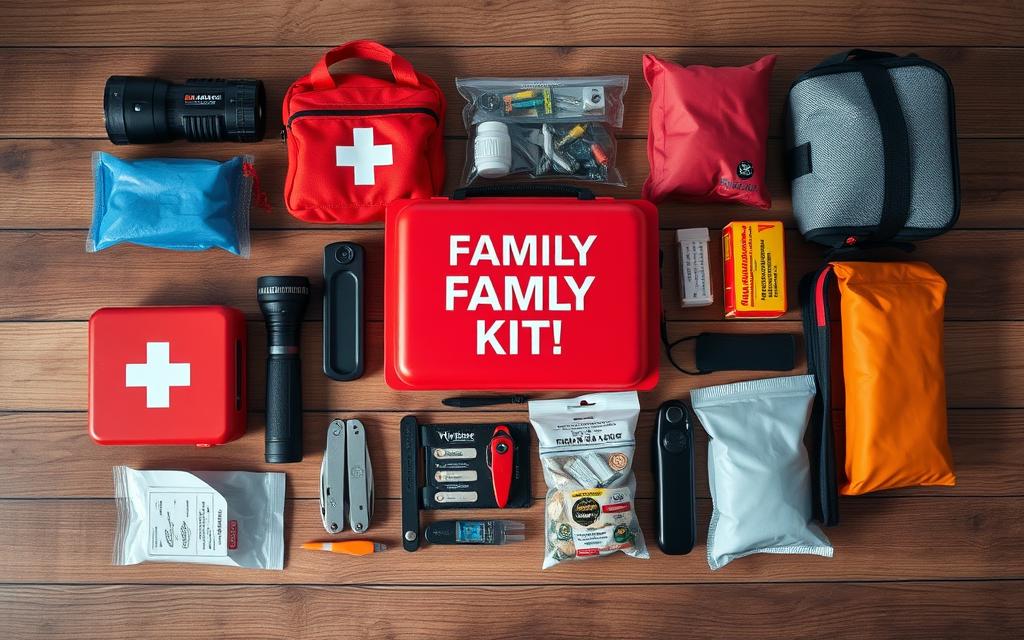
Don’t forget practical additions. Diapers, formula, or allergy-friendly snacks keep little ones safe. A backpack with adjustable straps works well for teens to carry their personal gear. Label each bag clearly to avoid mix-ups.
Adapting to Family-Specific Needs and Climates
Your local climate shapes what goes into the kit. Families in hurricane zones might add waterproof pouches for documents. Those in snowy areas pack hand warmers and thermal blankets. Always include extra water—one person might need more than a gallon daily in hot regions.
Review your setup every six months. Swap seasonal clothes, update photos for identification, and check expiration dates. A well-planned kit grows with your family, turning uncertainty into confidence.
Step-by-Step Guide to Assembling Your Emergency Kit
Putting together a reliable kit doesn’t have to feel overwhelming—it’s about smart choices and simple steps. Let’s walk through how to gather essentials and pack them for instant access when time matters most.
Collecting Basic Items and Supplies
Start by spreading out all your items on a table or floor. Use a printed checklist to tick off water, snacks, first-aid tools, and hygiene products. Store smaller things like matches or medications in resealable plastic bags to keep them dry. For bulky gear like flashlights, choose a sturdy duffel bag or bin.
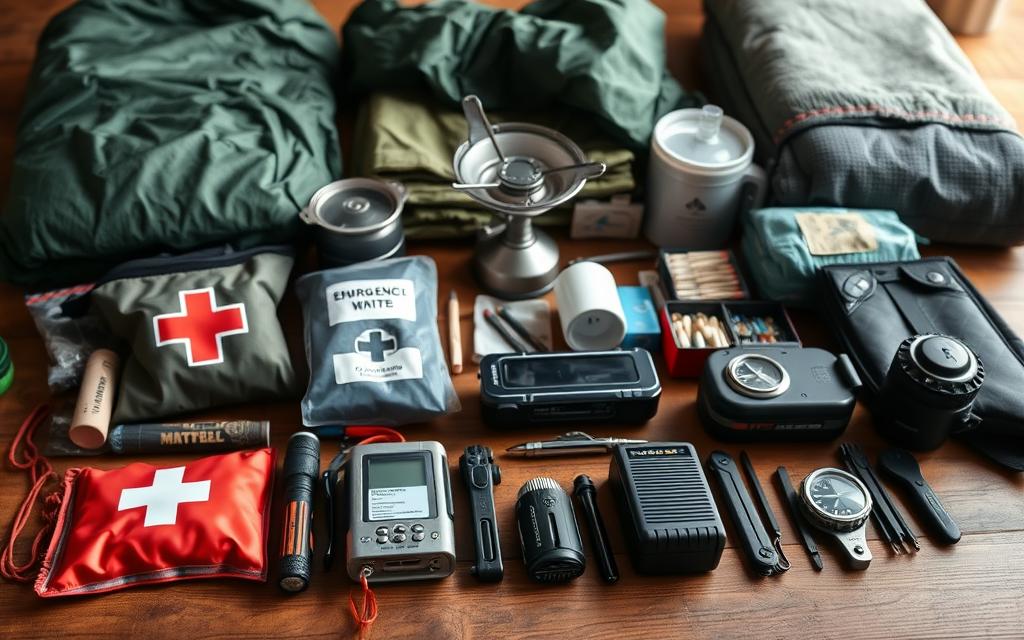
Organizing and Packing for Quick Access
Group similar items together—think “medical,” “food,” or “tools.” Label each category with paper tags taped to the outside of your bags. Place frequently used gear near the top. Keep your kit in a hand-carry container like a backpack near exits or under beds.
Before sealing everything, do a final sweep. Are expiration dates current? Does everyone know where it’s stored? For extra guidance, FEMA’s detailed checklist helps spot gaps. A well-organized system turns chaos into calm when seconds count.
Maintaining and Updating Your Disaster Preparedness Kit
Your disaster kit is only as good as its upkeep. Like checking smoke alarms or rotating pantry goods, keeping your gear fresh ensures it works when needed most. A forgotten expired snack or dead flashlight battery could turn a manageable situation into chaos.
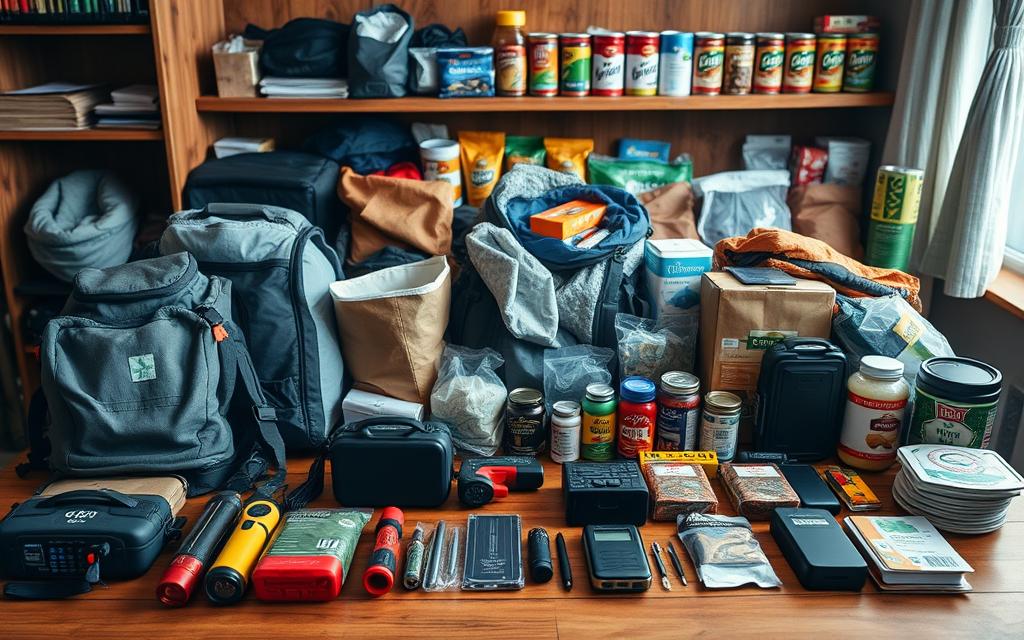
Regular Checks and Expiry Replacements
Set calendar reminders every six months to review your kit. Start with food and aid items—look for bulging cans or faded medication labels. Replace anything past its date, even if unopened. Rotate water bottles to keep them tasting fresh.
Use a permanent marker to write purchase dates on new additions. This simple trick helps track what needs swapping next. For cost savings, restock during back-to-school sales or holiday discounts on bulk packs.
Adjusting for Seasonal Shifts
Weather demands flexibility. Swap lightweight blankets for thermal ones in winter. Add sunscreen and insect repellent when summer hits. Families in flood zones might include waterproof document sleeves during rainy seasons.
Store your home kit in a cool, dry spot—like a hall closet—and test flashlights quarterly. Keep a printed checklist nearby to note missing items. Small tweaks today keep your family ready for tomorrow’s surprises.
Storage and Transportation: Home, Work, and Vehicle Kits
Where you store your gear can be as crucial as what’s inside. Smart placement ensures you can grab what’s needed fast—whether you’re at home, stuck at work, or miles from help during a roadside crisis.
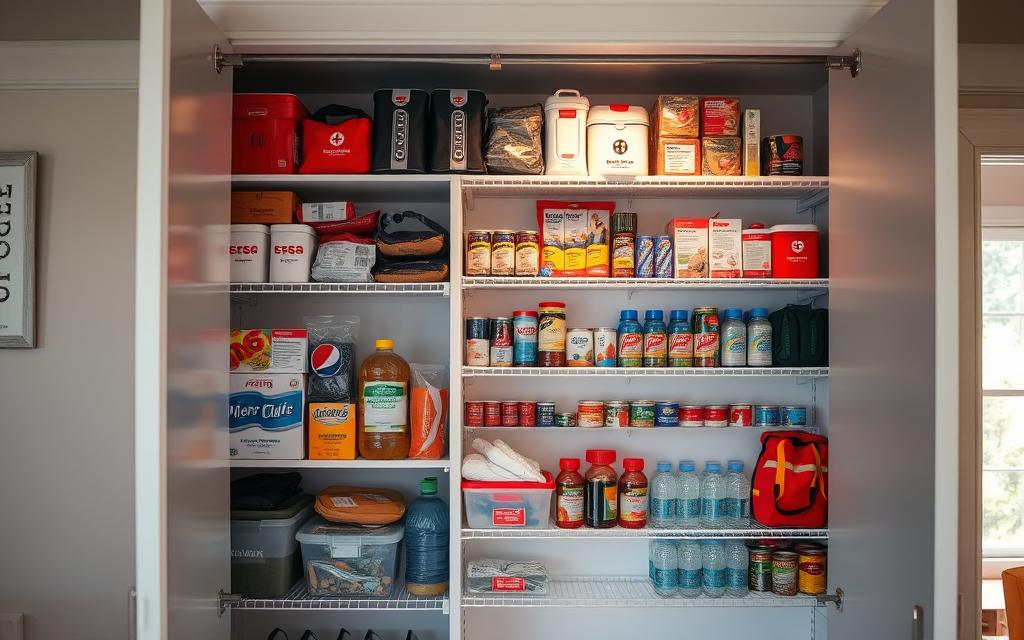
Creating Accessible Storage Locations
Start by choosing spots that balance security with quick access. At home, keep your main kit in a closet near exits. For work, tuck a slim backpack under your desk. Vehicle storage? Use a weatherproof bag in the trunk.
Three rules for ideal placement:
- Visibility: Label containers clearly so anyone can find them.
- Protection: Avoid damp basements or hot attics that ruin items.
- Consistency: Use matching color-coded packs for all locations.
Car kits deserve special attention. Include jumper cables, a blanket, and non-perishable snacks. A compact emergency kit here solves flat tires or sudden storms. Rotate seasonal supplies like ice scrapers every fall.
Test your setup quarterly. Can you reach each place blindfolded? Do zippers open smoothly? Quick fixes now prevent fumbles later when every second counts.
Using a Disaster Supplies Checklist Effectively
A well-crafted checklist acts like a roadmap for preparedness—guiding you through essentials without missing critical items. Think of it as your quality-control partner, ensuring every flashlight battery and hygiene wipe gets accounted for.
Printable Checklists and Custom Modifications
Start by downloading free templates from trusted sources like FEMA or the Red Cross. These paper-based guides cover universal basics—water, food, and first-aid kits. Print two copies: one for assembling your gear and another for future updates.
Customization is key. Cross out items that don’t fit your household. Add allergy-friendly snacks or pet medications using colored pens. Leave margin space for notes like “replace hand wipes every May” or “update contact information.”
Follow this simple process:
- Check off gathered items with a bold marker
- Staple receipts to pages for budget tracking
- Store the list in your kit for quick reference
Revisit your checklist during seasonal changes or family milestones. Did someone start college? Add dorm-friendly items. Moving to wildfire country? Highlight protective gear. Small tweaks keep your plan current and actionable.
Set phone reminders to review the list quarterly. Pair it with smoke alarm battery checks for consistency. A dynamic checklist grows with your needs, turning scattered kits into organized confidence.
Emergency Supplies for Unexpected Disaster Scenarios
Disasters don’t announce their arrival—your readiness determines how you weather the storm. From hurricanes to chemical spills, each situation demands specific tools and quick thinking. Tailoring your kit to address these variables bridges the gap between panic and proactive response.
Planning for Natural Disasters and Severe Weather
Wildfires, floods, and tornadoes each present unique challenges. Coastal homes need waterproof document cases, while tornado-prone areas require helmets and thick gloves. Always pack weather-specific gear like thermal blankets for blizzards or electrolyte tablets for heatwaves.
A durable backpack keeps essentials organized during evacuations. Include local maps, glow sticks, and a hand-crank radio. Families in Oklahoma survived a 2023 tornado by using their NOAA weather radio—a testament to smart preparation.
Preparing for Man-Made Emergencies
Power grid failures or civil disruptions require different strategies. Add N95 masks for air quality issues and cash in small bills. Include a laminated list of emergency contacts and a portable phone charger.
Experts at FEMA recommend keeping a mini first aid kit in every vehicle. Pair it with a multi-tool and high-calorie snacks. Regular drills ensure everyone knows where to find these items when tension runs high.
Updating your plan every season builds adaptability. Rotate water every six months and test flashlights quarterly. Preparedness isn’t about predicting chaos—it’s about crafting resilience one thoughtful step at a time.
Reviewing Popular Emergency Supply Kits on the Market
Choosing the right preparedness kit can feel overwhelming with so many options available. Let’s simplify your search by breaking down top-rated choices and their best uses.
Comparing Kit Options and Price Points
Popular kits range from compact backpacks to bulkier bucket designs. The 1-Person Backpack Kit ($50–80) includes basics like a first-aid pack, water pouches, and a flashlight. Larger families might prefer the 2-Person Bucket Kit ($60–100), which offers longer shelf life but less portability.
Key factors to compare:
- Contents: Check for critical items like thermal blankets or water filters.
- Shelf life: Bucket kits often last 5+ years versus 2–3 years for budget packs.
- Weight: Backpack-friendly options stay under 15 pounds for easy carrying.
Budget-Friendly versus Deluxe Kits
Affordable kits ($30–60) cover essentials but may lack tools like multi-purpose knives or NOAA radios. Deluxe versions ($120–200) add durable gear, including crank-powered chargers and waterproof shoes. For example, the Alpine Survivor backpack includes a 72-hour food supply and fire-starting tools.
Consider these trade-offs:
- Budget picks: Great for short-term needs but require frequent updates.
- Deluxe bundles: Higher upfront cost but better for multi-day scenarios.
Always verify expiration dates and storage information before purchasing. Your ideal kit balances cost, quality, and your household’s unique risks.
Preparing Your Emergency Kit for U.S. Conditions
Tailoring your kit to your region’s unique challenges transforms generic gear into life-saving tools. The U.S. spans deserts, coastlines, and tornado alleys—each demanding specific items. A Florida hurricane plan differs wildly from Alaska’s winter storm strategy.
Regional Risks and Climate Considerations
Coastal areas face flooding risks. Waterproof pouches for documents and sandbags become essentials. In earthquake zones like California, add sturdy shoes and dust masks. Midwestern tornado kits need helmets and thick gloves for debris handling.
Climate directly impacts hydration needs. Families in Arizona’s heat should store extra water—up to two gallons per person daily. Northern states prioritize thermal blankets and hand warmers during blizzards. Always check local disaster history when planning.
Include a laminated contact list for each family member. Pair it with a first aid manual addressing regional injuries—like snakebite kits in rural areas. Compact shelter items, like foldable tents, suit urban evacuations or wilderness scenarios.
Customization matters. Large families might add bulk food packs, while solo kits focus on portability. Update your gear every season, and practice evacuation routes. Smart adjustments today build confidence for whatever tomorrow brings.
Conclusion
Taking charge of your family’s safety starts with a well-planned kit that covers essentials like water, non-perishable food, and hygiene items. Whether facing a sudden storm or prolonged outage, these tools keep everyone secure until normalcy returns. Regular checks ensure nothing expires or goes missing when it matters most.
Building your kit is just the first step. Rotate items every six months and adjust for seasonal needs—like adding sunscreen in summer or extra blankets in winter. Tailor your gear to local risks, whether that’s waterproof pouches for floods or sturdy shoes for rough terrain.
Ready to act? Review your setup today. Ensure each bag has updated contact lists, first-aid basics, and comfort items for kids. Store everything in an easy-to-grab place everyone knows.
Preparedness isn’t about fear—it’s about confidence. A little effort now creates peace of mind later. Start small, stay consistent, and remember: your kit is the bridge between chaos and calm when life takes an unexpected turn.
